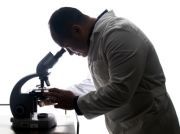What Can Pathophysiology Tell Us about the Management of Chronic Urticaria?
Research shows that although mast cells are key effector cells in the pathogenesis of urticaria, targeting individual mast cell mediators is often not therapeutically effective

Urticaria is not a single disease but rather is “a reaction pattern that represents cutaneous mast cell degranulation, resulting in extravasation of plasma into the dermis.” Because there are such a wide variety of potential triggers of urticaria, diagnosis and treatment can represent a significant challenge for clinicians. A greater understanding of the pathophysiology of this condition and its associated symptoms can help clinicians to more effectively manage them.
Thomas Casale, MD, Executive Vice President of the AAAAI, professor of medicine in the Division of Allergy/Immunology at the University of South Florida, began his talk on urticaria pathogenesis at the 2014 Annual Meeting of the American Academy of Allergy, Asthma & Immunology, held February 28 — March 4, 2014, in San Diego, CA, with a review of the pathophysiology of wheal and flare reactions and pruritis.
He noted that urticarial responses resemble wheal and flare reactions, and that the combination of wheal and flare reactions and pruritis is characteristic of chronic urticaria (CU). He said the release of neuropeptides is especially associated with pruritis, and that erythema (ie, flare) results from two factors: the axon reflex and mediator-induced vasodilation.
Mediators that can cause wheal and flare reactions include histamine and bradykinin, as well as prostaglandin E2 (PGE2) and prostaglandin D2 (PGD2), which are also mediators that can cause prolonged erythema.
Casale said the duration of action varies between mediators (for example, histamine is short-acting, while prostaglandins are long-acting), and that persistence of the condition can depend on the time course of these mediator actions. This is in part related to mediator-induced vascular permeability, which is caused by stimulation of endothelial receptors and increased permeability of cutaneous capillaries and postcapillary venules.
Allergens precipitate acute urticaria but their role in the development of CU is unclear. The allergen (antigen) binds to IgE and the complex associates with the mast cell via IgE receptor or Fc ɛRI binding. This triggers the ITAMs and Syk pathway. Several other pathways are then activated to produce histamine release, transcription factor activation and cytokine release, and phospholipase A2 activity leading to the release of prostaglandins and leukotrienes.
Casale reperatedly emphasized the central role of mast cells (and basophils) in this process. There are deleterious cycling (positive feedback) effects in mast cell interactions with nerve endings, especially in tryptase-intense pruritis. He described the various mediators in biological fluids in pruritis including the leukotrienes which, like prostaglandins, have a persistent effect. The presence of perivascular infiltrates may impact the efficacy of therapy.
Casale presented a table taken from what he called “a nice review,” published in Immunology and Allergy Clinics of North America, in which the authors “compared expression of SHIP-1, SHIP-2, and Syk protein to histamine release (HR) from mast cells (MC)” cultured from the peripheral blood of treatment responsive chronic idiopathic urticaria (CIU R), treatment nonresponsive (CIU NR), and normal subjects.” They reported increased spontaneous histamine release in CIU, especially in CIU R. The authors also reported observing changes in lymphocytes, peripheral blood mononuclear cells, peripheral blood dendritic cells, serum and coagulation. In serum, in particular, there were increased levels of a wide range of cytokines and other activating factors.
Casale said “we have the most knowledge” about the mast cell mechanism/paradigm of chronic urticaria. In autoimmune urticaria, possible therapeutic targets include Syk (a kinase). SHIP-1 and SHIP-2, which have inhibitory properties and are found in basophils and mast cells, offer another avenue. Casale referred to an article published in Clinical Reviews in Allergy Immunology that noted “Two mechanisms have been investigated as possibly contributing to the pathogenesis of chronic urticaria. One is the development of autoantibodies to FcεRI or IgE on mast cells and basophils. This appears to be responsible for 30—50% of cases. The other is dysregulation of intracellular signaling pathways involving Syk, SHIP-1, or SHIP-2 in basophils and mast cells.”
The question arises as to whether there are intrinsic differences in CU mast cells. Patients with CIU have different levels of key transcription factors such as SHIP-1, SHIP-2, and Syk. SHIP-2 expression is lower in responsive CIU patients compared to non-responsive CIU patients and normal subjects. LUVA, an immortalized mast cell line, has been employed as a model system for testing Syk inhibitors using percent inhibition of PgD2 secretion as the indicator.
There are different responses to mast cell mediators in CU for flare versus wheal and there are chronic autoimmune and chronic idiopathic urticaria subtypes. There is a question as to whether certain features of acute urticaria, such as basopenia and the development of autoantibodies, apply to the chronic disease. There appear to be autoantibodies to IgE or Fc ɛRI in 30-50% of CU cases which may respond to treatment with plasmapheresis, IGIV, etc.
Although omalizumab seems to work in CU, its mechanism of action is still unknown. There are indications toward the roles of IgE and Fc ɛRI, but Casale noted there are also several confounding issues. It should be taken into account that 50% of CU cases are resistant to antihistamine treatment.
Casale concluded by repeating his main point that mast cells are key effector cells in the pathogenesis of urticaria. Targeting individual cell mediators is often not therapeutically effective since patients with CU are likely to have circulating factors (both Ig and non-Ig) that promote mast cell degranulation and there appear to be intrinsic differences in mast cells.